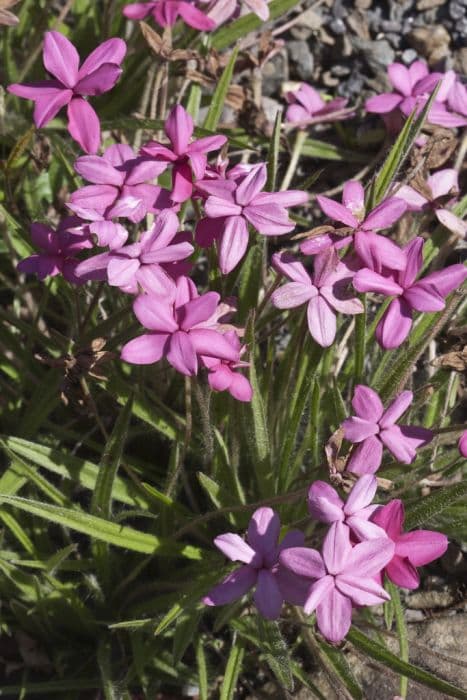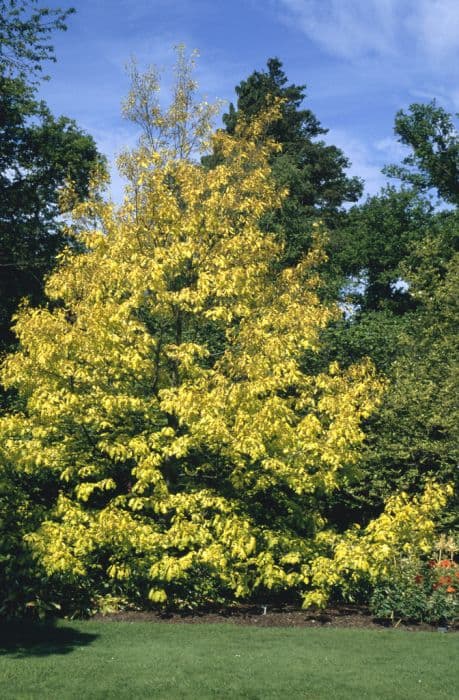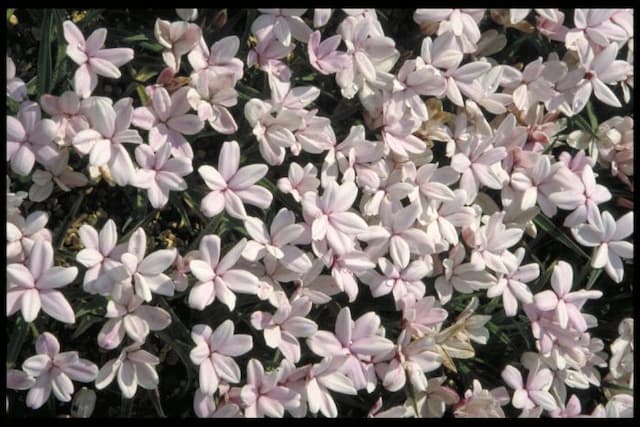Red Star Rhodohypoxis baurii 'Susan Garnett-botfield'

ABOUT
Rhodohypoxis baurii 'Susan Garnett-Botfield', commonly known as Rhodohypoxis, is an eye-catching perennial with a compact growth habit. It features slender green leaves that emerge in tufts, resembling a clump of grass in texture and form. During its flowering season, this plant produces beautiful blooms that captivate onlookers. These flowers boast a vibrant pink color, ranging from pale pastels to deeper rosy hues, each with a distinctive star-shaped arrangement. The petals are delicate and pointed, radiating from the center to create a mesmerizing pattern akin to a pinwheel or a miniature lily. These blooms are carried atop slender stalks that rise just above the foliage, creating a delightful contrast against the green backdrop. Rhodohypoxis baurii 'Susan Garnett-Botfield' is a charming plant that adds pops of color and texture to gardens and container displays, captivating with its lush foliage and enchanting blooms.
About this plant
 Names
NamesFamily
Hypoxidaceae.
Synonyms
Rhodohypoxis, Red Star.
Common names
Rhodohypoxis baurii 'Susan Garnett-botfield'.
 Toxicity
ToxicityTo humans
There is no widespread evidence to suggest that the plant commonly known as Rhodohypoxis is toxic to humans. As such, if ingested, it is unlikely to cause serious harm or poisoning. However, as with any non-food plant, individual allergic reactions or sensitivities are possible, and it's generally advisable to avoid eating ornamental plants.
To pets
Rhodohypoxis, the common name of the plant in question, does not appear on the major toxic plant lists for pets, and there is no common knowledge of toxicity to household pets such as dogs and cats. Nevertheless, it is always prudent to prevent pets from ingesting plants not specifically intended for their consumption, since individual animals may have adverse reactions, and non-food plants can cause gastrointestinal upset or other non-toxic-related issues.
 Characteristics
CharacteristicsLife cycle
Perennials
Foliage type
Deciduous
Color of leaves
Green
Flower color
Varies
Height
6 inches (15 cm)
Spread
6 inches (15 cm)
Plant type
Bulb
Hardiness zones
7
Native area
South Africa
Benefits
 General Benefits
General Benefits- Easy to Grow: Rhodohypoxis 'Susan' is considered easy to care for and can thrive with minimal attention, making it a good choice for novice gardeners.
- Attractive Flowers: It produces vibrant pink flowers that add a pop of color to gardens and landscapes from spring to early summer.
- Compact Size: The plant remains small and compact, making it suitable for rock gardens, alpine troughs, and containers where space is limited.
- Drought Tolerant: Once established, it has low water requirements and can tolerate periods of drought, reducing the need for frequent watering.
- Groundcover: Rhodohypoxis 'Susan' can serve as an effective groundcover, filling in spaces and suppressing weed growth with its dense foliage.
- Seasonal Interest: It provides seasonal interest with its blooming period and can be paired with other perennials for prolonged garden appeal.
- Non-Invasive: The plant is non-invasive and will not spread aggressively, making it a good neighbor to other plants in the garden.
- Cold Hardy: It is relatively cold hardy, capable of withstanding cooler temperatures and surviving in various climates with appropriate winter protection.
 Medical Properties
Medical PropertiesThis plant is not used for medical purposes.
 Air-purifying Qualities
Air-purifying QualitiesThis plant is not specifically known for air purifying qualities.
 Other Uses
Other Uses- Photographic Subject: Rhodohypoxis baurii can be a charming subject for nature photographers, particularly macro photography enthusiasts, because of its delicate, star-shaped flowers.
- Artistic Inspiration: Artists may use the Rhodohypoxis baurii's vibrant colors and unique shape as inspiration for paintings, drawings, or textile designs.
- Fairy Gardens: Due to their small size and enchanting appearance, these plants are perfect for creating fairy gardens and other miniature landscapes.
- Educational Tool: Botany teachers and educators can use Rhodohypoxis baurii as a live example when teaching about bulbous plants or alpine flora.
- Gift Plant: Its attractive blooms and compact size make Rhodohypoxis baurii a popular choice as a living gift, especially for plant enthusiasts.
- Jewelry Making: Pressed flowers of Rhodohypoxis baurii can be incorporated into handmade jewelry, such as pendants or earrings, preserving their beauty in resin.
- Ice Cubes: The small flowers can be frozen into ice cubes to add an elegant and colorful touch to drinks at garden parties or other events.
- Baking Decorations: Edible varieties of Rhodohypoxis baurii can be used to decorate cakes and desserts, provided they have not been treated with any harmful chemicals.
- Seasonal Crafts: The flowering bulbs of Rhodohypoxis baurii can be integrated into seasonal craft projects, such as wreaths or table centerpieces.
- Container Gardening: Due to its compact nature, Rhodohypoxis baurii is well-suited for container gardening, adding a splash of color to balconies, patios, or small urban spaces.
Interesting Facts
 Feng Shui
Feng ShuiThe Rhodohypoxis is not used in Feng Shui practice.
 Zodiac Sign Compitability
Zodiac Sign CompitabilityThe Rhodohypoxis is not used in astrology practice.
 Plant Symbolism
Plant Symbolism- Hope: Rhodohypoxis baurii, commonly known as Rhodohypoxis, often blooms after harsh conditions, symbolizing hope for better times after difficulties.
- Renewal: The rejuvenation of its flowers each season signifies renewal and the continuous cycle of life.
- Adaptability: This plant's ability to adapt to varying conditions represents the human quality of resilience and flexibility.
- Purity: The delicate and simple appearance of Rhodohypoxis blossoms can symbolize purity and innocence.
- Charm: With its attractive flowers, Rhodohypoxis is often seen as a symbol of charm and attractiveness.
 Water
WaterThe Rhodohypoxis, commonly known as the Red Star plant, prefers evenly moist soil during its growing season. During spring and summer, water the plant once the top inch of soil feels dry, which may be approximately once a week, using about 8 ounces of water each time. When the plant is dormant in winter, reduce watering significantly and only provide enough to prevent the soil from completely drying out, less than 4 ounces every few weeks should suffice. Avoid waterlogging as it can lead to root rot.
 Light
LightRed Star plants thrive best in bright, indirect light. They appreciate some morning sun but should be protected from the harsh midday sun, which can scorch their delicate leaves. A spot near an east-facing window where the plant can receive gentle morning sunlight and dappled light throughout the day is ideal.
 Temperature
TemperatureRed Star plants prefer a temperature range of 50°F to 75°F for optimal growth, but they can survive down to 40°F. They should not be exposed to temperatures below freezing as they are not frost-tolerant. Ensure to keep the plant in a location where it is protected from extreme temperature fluctuations.
 Pruning
PruningPruning the Red Star plant is mainly done to remove spent flowers and dead or yellowing foliage. This promotes better growth and a tidier appearance. Pruning should be done after the flowering season, using clean and sharp scissors or pruning shears to snip off dead material.
 Cleaning
CleaningAs needed
 Soil
SoilThe best soil mix for Red Star or Rhodohypoxis baurii 'Susan Garnett-Botfield' is well-draining and rich in organic matter, like a mix of loam, peat, and sharp sand. The ideal soil pH for Red Star should be slightly acidic to neutral, ranging from 5.5 to 7.0.
 Repotting
RepottingRed Star or Rhodohypoxis baurii 'Susan Garnett-Botfield' typically needs repotting every 2-3 years to refresh the soil and accommodate the growth of the corms. It's best to repot in late winter or early spring before new growth begins.
 Humidity & Misting
Humidity & MistingRed Star or Rhodohypoxis baurii 'Susan Garnett-Botfield' prefers moderate to high humidity levels for optimal growth. The best humidity level for this plant ranges from 50% to 70%.
 Suitable locations
Suitable locationsIndoor
Bright, indirect light and cool temperatures for Red Star.
Outdoor
Plant in partial shade, protect from frost.
Hardiness zone
7-9 USDA
 Life cycle
Life cycleRhodohypoxis baurii 'Susan Garnett-botfield', commonly known as Rhodohypoxis, begins its life cycle as a small bulb-like corm. In early spring, new shoot growth emerges from the corm, and the plant enters its vegetative growth phase, producing narrow, grass-like leaves. Through late spring to summer, Rhodohypoxis produces numerous small, star-shaped flowers that can range from white to pink or red. After flowering, the plant sets seed, which can be dispersed for propagation, though Rhodohypoxis is often also propagated by dividing corms. In late summer or early autumn, the plant's above-ground foliage dies back, and it enters a period of dormancy, during which the corm survives underground. With the onset of the next spring, the cycle begins anew with the corm producing fresh growth, resuming its perennial life cycle.
 Propogation
PropogationPropogation time
Spring to summer
The Rhodohypoxis baurii 'Susan Garnett-botfield', commonly referred to as Red Star, can be propagated through the division of clumps. This process is best done in the late winter to early spring before new growth begins. To propagate Red Star by division, carefully lift the plant out of the ground or container, and gently separate the clumps into smaller sections, each with a few leaves and roots attached. These divisions can then be replanted into pots with well-draining soil, placed at the same depth they were growing previously. Water the newly placed divisions thoroughly to settle the soil around the roots and keep the soil moist, but not waterlogged, as the plants establish.
![Rhodoxis [Fairytale]](/_next/image?url=https%3A%2F%2Fplants-admin.emdemapps.com%2Fimages%2Fplants%2F%2Fimages%2F604b54204420d.png&w=640&q=75)



